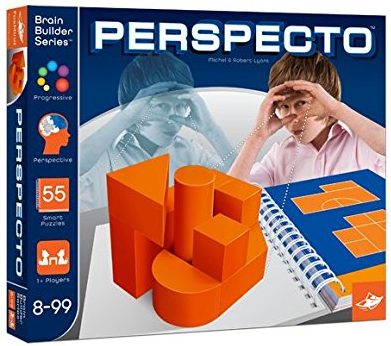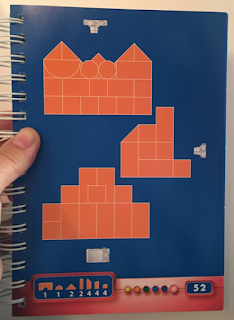 |
| Perspecto - A spatial, logic, deductive reasoning, problem solving puzzle |
In the box: 18 solid plastic pieces, book with 55 puzzles
Perspecto is one of the four-part, award-winning brain builder series from FoxMind. FoxMind is a company known for its challenging logic puzzles, and if you are working on spatial skills, this may just be the game for you.
Looking at the 2D models in the pattern book, build upright 3D models. The pieces needed for each model will be shown at the bottom of each page (bottom left). Pieces may look very different from different perspectives and there is a chart included in the book so that you can see each piece from the most common views including front, rear, right, left, below, and above. The 55 puzzles in the spiral-bound book increase in difficulty as you go, so the player will continue to be challenged as he advances. The Perspecto game is different from the other three games in the series in that some of these puzzles offer you more than one perspective, as show in the puzzle below.
The four different games in this series are Equilibrio, Perspecto (used to be called Cliko), Architecto, and Tangramino, and they all use the same 18 pieces. Here is some information on each game:
- Equilibrio - Build structures upright, some with challenging balance aspects.
- Perspecto - Build structures from a variety of perspectives (up to three views per puzzle). The old name for this game is Cliko. The Perspecto puzzle book is the exact same book as the Cliko book, just a new name.
- Architecto - Build structures upright.
- Tangramino - Build structures flat on the table.
For more of this type of activity, see my post on What's in Your Therapy Box? Pattern Block Edition.
Try this:
- Start by examining each piece and comparing it to the chart. Discuss how one piece can look different when looking at it from different perspectives.
- Copy the chart so that you can use it as a reference while you are building.
- Build the model on top of the book first, then move to building it beside the book. Images in the book are the correct size to do this.
- Orient a puzzle piece and place it on the model if an individual gets stuck or cannot orient the piece correctly. Then pick it up, turn it askew, and hand it to the individual to orient. The individual may not be able to "see" the shape as it would look in a different orientation and a visual demonstration like that can help a great deal.
- Use consistent directional and positional language as you cue.
- Work on visual discrimination, visualization, spatial relations, position in space, visual closure, visual form constancy, eye-hand coordination, manual dexterity, in-hand manipulation, coordinated use of both hands, deductive reasoning, logic, problem solving, executive functioning skills, process skills, play and leisure exploration and participation
In the box: 18 solid plastic pieces, book with 55 puzzles
If you are interested in purchasing this item or just want more information, click on the image below.




No comments:
Post a Comment
Thank you for taking the time to comment.